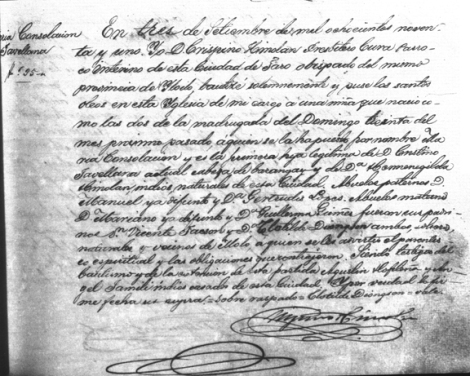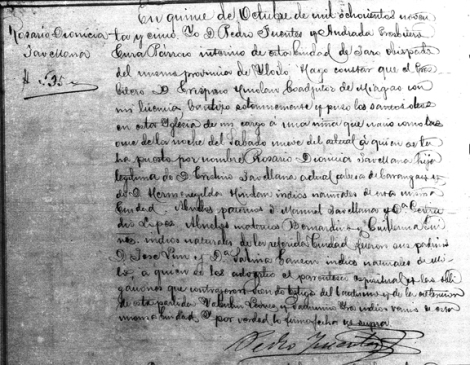

Above are baptismal entries for Maria Consolacion Hinolan Javellana (top image) and Rosario Dionicia Hinolan Javellana (bottom image), microfilmed from the archives of St. Elizabeth of Hungary Metropolitan Cathedral in Jaro, Iloilo and now made accessible to the public at the Mormon Family History Library in Utah, USA.
These documents described Don Cristino Javellana, son of Don Manuel Javellana and Doña Gertrudis Lopez, as a Cabeza de Barangay in the City of Jaro, Province of Iloilo.
However, the baptismal entry for Maria Consolacion (born 1891) identifies her maternal grandfather as Don Mariano Hinolan (husband of Doña Guillerma Guiñes), while the baptismal entry for Rosario Dionicia (born 1895) identifies her maternal grandfather as Don Bernardino Hinolan.
Images courtesy of Stephen Renouf
-oOo-
The Cabeza de Barangay (Spanish for head of the barangay) was the leader or chief of a barangay in Spanish Philippines. The post was inherited from the first datus who became cabezas de barangay when the many independent barangays fall under the rule of the Spanish Crown. King Philip II, after whom the Philippines was named, decreed that the native nobilities of the country should retain the honors and privileges they had before their conversion and subjection to the Spanish Crown.
Since in the new form of government introduced by Spain several ancient, neighboring barangays were combined to form a municipality, the Cabezas de Barangay participated in the governance of the town and formed part of the elite ruling class called the Principalía. From among their ranks the head of the town, the Gobernadorcillo or Capitan Municipal, was elected. Furthermore, only the members of their class could elect the Gobernadorcillo.
The office of the Cabeza de Barangay was hereditary. When the office of the Cabeza de Barangay falls vacant either for lack of an heir or through the resignation of the incumbent, a substitute is appointed by the superintendent if the barangay is near the capital of the province. In distant areas, the appointment was done by the respective delegate, but at the proposal of the Gobernadorcillo and other cabezas.The cabezas, their wives, and first-born sons enjoyed exemption from the payment of tribute to the Spanish Crown.
With the change of government (from monarchy to democracy) when the Americans took over the rule of the Philippines, the post became elective and anyone could become the head of the barangay, which came to be called a “barrio”. The former Cabezas de Barangay and the rest of the members of the Principalía and their descendants lost their traditional status, privileges and powers.
Under the democratic rule, the head of the smallest unit of the Filipino society no was no longer called “Cabeza de Barangay”. Furthermore, the “Barrio Captains” (or Capitán del barrio as these local leaders were then called) though exercising the same leadership function, no longer retained the aristocratic quality that was associated to this office during the pre-conquest and the colonial periods.
During the incumbency of President Ferdinand E. Marcos, the term “barangay” was re-adopted. However, the title “Cabeza de Barangay” was not used to refer to the office of the political leaders of the barangay. Instead, the term “Barangay Captain” (Tagalog: punong-baranggay) came into use until the present.
Source: Wikipedia
